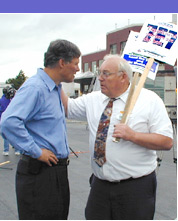Jay Inslee: Washington's 1st Congressional District
Home > Legislative Issues > Tsunami Detection > Deep Water Buoy Tour
Legislative Issues
Tsunami Detection
Inslee Meets with Scientists about Early Tsunami Warnings
6 January 2005
U.S. Rep. Jay Inslee called a meeting with scientists from the National Oceanic and Atmospheric Administration (NOAA) and Kirkland-based Paroscientific Inc. to discuss the use of deep ocean buoys in detecting tsunamis and providing tsunami warnings. The meeting at NOAA’s Sand Point facility included a demonstration of the deep ocean buoys, which are equipped with pressure transducers made by Paroscientific that are precise enough to detect a tsunami as small as two centimeters in height. Computer simulations of tsunamis were also displayed.
The United States currently has six West Coast deep water buoys in place. Pressure sensors in the buoys detect changes in deep water that are indicative of passing tsunamis. The data from the buoys is transmitted to a satellite, and then back to scientists at Tsunami Warning Centers in Hawaii and Alaska. Inslee is advocating that the U.S. government purchase an additional fifteen deep ocean buoys for the West Coast.

Inslee learns about a buoyancy system to retrieve the pressure transducer from the ocean floor from Christian Meinig, NOAA Pacific Marine Environmental Laboratory Engineering Development Division, and E.N. Bernard Ph.D., Director of the NOAA Pacific Marine Environmental Laboratory Engineering Development Division.

Inslee and Meinig stand between two large deep ocean buoys on land at NOAA’s Sand Point facility in Seattle. The buoys house the communication equipment that relays information from the tsunometer on the seafloor to satellites. The red buoy on the left is currently used by the United States and Chile to monitor changes in the Pacific Ocean. Deploying this first generation model is both dangerous and expensive. The yellow buoy to the left is a second generation buoy, and it is designed to self-deploy and to anchor the transducer assembly. The new yellow buoys are less expensive and less dangerous to use.

Meinig explains how the pressure transducer inside of the tsunometer functions to Inslee, Steve Smith (Sales and Applications Engineer for Paroscientific, Inc.), and Dr. Bernard. Paroscientific Inc. in Redmond makes the instrument inside of the buoy tsunometers.




